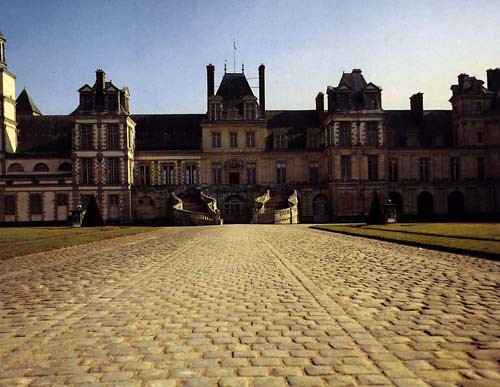The palace in which every king of France since the Middle-Ages had lived was spared during the Revolution, but the furniture was either destroyed or sold. Napoleon had the palace both restored and refurbished, thus making it once again a residence fit for royal guests. Almost 600 rooms were transformed to accommodate the court, and the furniture needed for them was either taken out of storage or orders were placed with cabinet-makers such as (Jacob-Desmalter…) and with tapestry-makers such as Baudoin, Legendre, and Decors.
Pope Pius VII came to Fontainebleau to officiate at Napoleon's coronation. The Emperor made a few visits to the estate between two military campaigns in the spring of 1805 and the in the autumns of 1807, 1809 and 1810. He held the Pope prisoner here between 1812 and 1814 and he spent his last days in the château before abdicating on 6th April, 1814. He left the estate on 20th April, after the famous farewell ceremony during which he delivered a speech to his soldiers assembled before him in the Cour du Cheval Blanc. It ended with the following words: “Adieu my children! I would like to clasp every one of you to my breast: I shall at least clasp your flag”. And he did so before entering his carriage and leaving for Elba.
The most significant alteration undertaken in the palace was the transformation, in 1808, of the king's bedroom into the throne room following drawings by Percier and Fontaine. It is the only French Royal throne room existing today which is complete with its furniture. The “Grand salon” and the Empress's bedroom were also decorated in Empire style. Napoleon's suite was entirely remodelled again in 1804. The most spectacular room remains the Emperor's bedroom which later on became the bedroom of all the sovereigns until 1870. The small bedroom, the private room also known as the “Abdication room”, the “passage to the bath-house” and the aides-de-camp's common room complete this magnificent suite which was restored between 1987 and 1995. On the ground floor, under the François I gallery, the smaller rooms for the Emperor and his wife were altered in 1808 and 1810 and reserved for the imperial couple's personal use.
In 1979, as a result of a donation of many objects by Prince Napoleon and Princess Marie-Clotilde, the state Napoleonic collections were redistributed within all State museums. A museum entirely devoted to Napoleon Bonaparte was thus created in Fontainebleau, its aim being to present a view of the Emperor and his family. It was set up in the Louis XV wing, a part of the château which had been restored by Napoleon in 1810 and which before that restoration (from 1803 to 1808) had been the headquarters of the the special military academy, later known as Saint-Cyr. The exhibition begins by introducing Napoleon and Josephine and the splendour of the imperial regime, before turning to Marie-Louise, the King of Rome and Napoleon's mother, as well as his brothers and sisters, all of whom played a part during this period. Special attention has been paid to the fabric on the walls and furniture in order to present the portraits, the memorabilia, the arms, the china, the gold and silver objects and the items of clothing in luxurious surroundings.
Fontainebleau also played a role in the Second Empire. With the return of the Empire with Napoleon III in the period between 1852 and 1870, Fontainebleau was once more an imperial château. This period is represented today by the Diane gallery (converted into a gallery) and the Empress Eugenie's Chinese museum set up in the rooms of Napoleon III, restored and opened in 1991. In these warm typically Second Empire rooms, this surprising collection of oriental art is made up of the spoils seized, during the Anglo-French campaign of 1860, from the summer residence of the Chinese emperors near Peking. There are also items which were given as presents by the Siamese Ambassadors during a reception in Fontainebleau on June 21, 1861. The current display preserves the arrangement designed by the Empress herself.
Fontainebleau Château Museum


